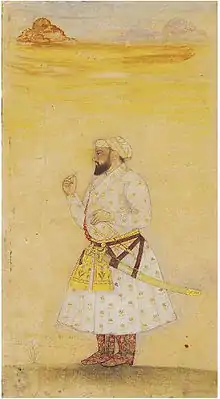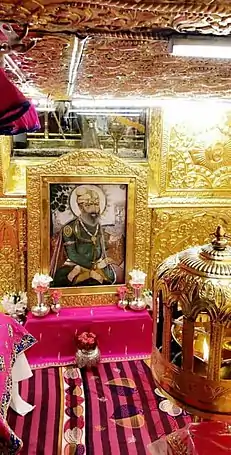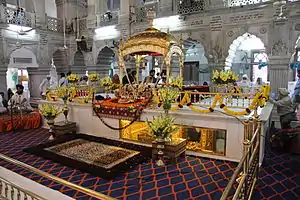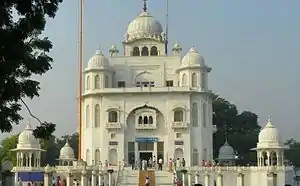Guru Tegh Bahadur
Guru Tegh Bahadur (Gurmukhi: ਗੁਰੂ ਤੇਗ ਬਹਾਦਰ, pronunciation: (Punjabi: [gʊɾuː t̯eːgᵊ bəɦaːd̯ʊɾᵊ]; 1 April 1621 – 11 November 1675)[7][8] was a ninth of ten Gurus who founded the Sikh religion and he was head of the followers of Sikhism from 1665 until his beheading in 1675. He was born in Amritsar, Punjab, India in 1621 and was the youngest son of Guru Hargobind Sahib, the sixth Sikh guru. Not just a principled and fearless warrior, he was a learned spiritual scholar and poet whose 115 hymns are included in Sri Guru Granth Sahib, the main text of Sikhism.
Guru Tegh Bahadur | |
|---|---|
 Portrait of Guru Teg Bahadur | |
| Personal | |
| Born | (Baba) Tyag Mal 1 April 1621 |
| Died | 11 November 1675 (aged 54) |
| Cause of death | Beheading |
| Religion | Sikhism |
| Spouse | Mata Gujri |
| Children | Guru Gobind Singh |
| Parents | Guru Hargobind and Mata Nanaki |
| Known for | |
| Religious career | |
| Period in office | 1665–1675 |
| Predecessor | Guru Har Krishan |
| Successor | Guru Gobind Singh |
| Part of a series on |
| Sikhism |
|---|
 |

Guru Tegh Bahadur was executed (by beheading) on the orders of Aurangzeb, the sixth Mughal emperor, in Delhi, India.[3][9][10] Sikh holy premises Gurudwara Sis Ganj Sahib and Gurdwara Rakab Ganj Sahib in Delhi mark the places of execution and cremation of Guru Tegh Bahadur.[11] His martyrdom is remembered as the Shaheedi Divas of Guru Tegh Bahadur every year on 24 November, according to the Nanakshahi calendar released by the Shiromani Gurdwara Parbandhak Committee in 2003.[12]
Biography
Tegh Bahadur was the youngest son of Guru Hargobind, the sixth guru: Guru Hargobind had one daughter, Bibi Viro, and five sons: Baba Gurditta, Suraj Mal, Ani Rai, Atal Rai, and Tyaga Mal. Tyaga Mal was born in Amritsar in the early hours of 1 April 1621. He came to be known by the name Tegh Bahadur (Mighty of the Sword), given to him by Guru Hargobind after he had shown his valor in a battle against the Mughals.[13]
Amritsar at that time was the center of the Sikh faith. As the seat of the Sikh Gurus, and with its connection to Sikhs in far-flung areas of the country through the chains of Masands or missionaries, it had developed the characteristics of state capital. Tegh Bahadur was brought up in a Sikh culture and trained in archery and horsemanship. He was also taught the old classics such as the Vedas, the Upanishads, and the Puranas. He preferred prolonged spells of seclusion and contemplation. Tegh Bahadur was married on 3 February 1633 to Mata Gujri.[14][15]
Stay at Bakala
In the 1640s, nearing his death, Guru Hargobind and his wife Nanki moved to his ancestral village of Bakala in Amritsar district, together with Tegh Bahadur and Mata Gujri. Bakala, as described in Gurbilas Dasvin Patishahi, was then a prosperous town with many beautiful pools, wells, and baolis. After Guru Hargobind's death, Tegh Bahadur continued to live in Bakala with his wife and mother. [16]
Guruship
In March 1664 Guru Har Krishan contracted smallpox. When asked by his followers who would lead them after him, he replied Baba Bakala, meaning his successor was to be found in Bakala. Taking advantage of the ambiguity in the words of the dying Guru, many installed themselves in Bakala, claiming themselves as the new Guru. Sikhs were puzzled to see so many claimants.[17][18]
Sikh tradition has a myth concerning the manner in which Tegh Bahadur was selected as the ninth guru. A wealthy trader, Baba Makhan Shah Labana, had once prayed for his life and had promised to gift 500 gold coins to the Sikh Guru if he survived.[17] He arrived in search of the ninth Guru. He went from one claimant to the next making his obeisance and offering two gold coins to each Guru, believing that the right guru would know that his silent promise was to gift 500 coins for his safety. Every "guru" he met accepted the 2 gold coins and bid him farewell.[17] Then he discovered that Tegh Bahadur also lived at Bakala. Labana gifted Tegh Bahadur the usual offering of two gold coins. Tegh Bahadur gave him his blessings and remarked that his offering was considerably short of the promised five hundred. Makhan Shah Labana forthwith made good the difference and ran upstairs. He began shouting from the rooftop, "Guru ladho re, Guru ladho re" meaning "I have found the Guru, I have found the Guru".[17]
In August 1664 a Sikh Sangat arrived in Bakala and anointed Tegh Bahadur as the ninth guru of Sikhs. The Sangat was led by Diwan Durga Mal, and a formal "Tikka ceremony" was performed by Baba Gurditta, elder brother of Guru Tegh Bahadur, conferring Guruship on Him.[18]
As had been the custom among Sikhs after the execution of Guru Arjan by Mughal Emperor Jahangir, Guru Tegh Bahadur was surrounded by armed bodyguards.[19] He himself lived an austere life.[20]
Works
Guru Tegh Bahadur contributed many hymns to Granth Sahib including the Saloks, or couplets near the end of the Guru Granth Sahib.[20] Guru Tegh Bahadur toured various parts of the Mughal Empire and was asked by Gobind Sahali to construct several Sikh temples in Mahali. His works include 116 shabads, 15 ragas, and his bhagats are credited with 782 compositions that are part of bani in Sikhism.[21]
His works are included in the Guru Granth Sahib (pages 219–1427).[22] They cover a wide range of topics, such as the nature of God, human attachments, body, mind, sorrow, dignity, service, death, and deliverance. For example, in Sorath rag, Guru Tegh Bahadur describes what an ideal human being is like,[22]
jo nar dukh mein dukh nahin manney, sukh snehh ar phey nahi ja kai, kanchan maati manney
na nindya nehn usttat ja kai lobh moh abhimana
harakh sog tey rahey niaro nahen maan apmana, aasa mansa sagal tyagey
jagg tey rahey nirasa, kaam krodh jeh parsai nahin the ghatt brahma niwasa
One who is not perturbed by misfortune, who is beyond comfort, attachment, and fear, who considers gold as dust. He neither speaks ill of others nor feels elated by praise and shuns greed, attachments, and arrogance. He is indifferent to ecstasy and tragedy, is not affected by honors or humiliations. He renounces expectations, greed. He is neither attached to the worldliness nor lets senses and anger affect him. In such a person resides God.— Guru Tegh Bahadur, Sorath 633 (Translated by Gopal Singh), [22]
Journeys
Guru Tegh Bahadur traveled extensively in different parts of the country, including Dhaka and Assam, to preach the teachings of Nanak, the first Sikh guru. The places he visited and stayed in became sites of Sikh temples.[23]
During his travels, Guru Tegh Bahadur spread the Sikh ideas and message, as well as started community water wells and langars (community kitchen charity for the poor).[24][25]
The Guru made three successive visits to Kiratpur. On 21 August 1664, Guru went there to console with Bibi Rup upon the death of her father, Guru Har Rai, the seventh Sikh guru, and of her brother, Guru Har Krishan. The second visit was on 15 October 1664, at the death on 29 September 1664, of Bassi, the mother of Guru Har Rai. A third visit concluded a fairly extensive journey through the northwest Indian subcontinent. His son Guru Gobind Singh, who would be the tenth Sikh guru, was born in Patna, while he was away in Dhubri, Assam in 1666, where stands the Gurdwara Sri Guru Tegh Bahadur Sahib. He there helped end the war between Raja Ram Singh of Bengal and Raja Chakardwaj of Ahom state (later Assam).[24][26] He visited the towns of Mathura, Agra, Allahabad and Varanasi.[27]
After his visit to Assam, Bengal and Bihar, the Guru visited Rani Champa of Bilaspur who offered to give the Guru a piece of land in her state. The Guru bought the site for 500 rupees. There, Guru Tegh Bahadur founded the city of Anandpur Sahib in the foothills of Himalayas.[9][28] In 1672, Tegh Bahadur traveled through Kashmir and the North-West Frontier, to meet the masses, as the persecution of non-Muslims reached new heights.[29]
Execution by Aurangzeb

In 1675 Guru Tegh Bahadur was executed in Delhi on 24 November under the orders of the Mughal Emperor Aurangzeb.[3][1] According to J.S. Grewal, a scholar of Sikh history, Guru Tegh Bahadur decided to confront the religious persecution of Kashmiri Hindus by the Mughal officials.[30][31] He did so after appointing his son the successor-Guru, leaving his base of Makhowal and entering Ropar where he was promptly arrested.[30] According to Purnima Dhavan – a scholar of South Asian history and Mughal Empire, the Mughal administration kept a close watch on his activities.[32] Guru Tegh Bahadur was kept in jail for four months in Sirhind, then transferred to Delhi in November 1675.[30] There he was asked to perform a miracle to prove his nearness to his God. The Guru questioned the idea that "occult powers were not a proof of one's nearness to God", states Grewal.[30] After his refusal to perform a miracle, he was asked to convert to Islam. He refused. Three of his colleagues, who had been arrested with him, were then put to death in front of him.[30] He continued his refusal to convert to Islam. Thereafter, states Grewal, he was publicly beheaded in Chandni Chowk, a market square close to the Red Fort.[30][31]
According to the official account of the Mughal Empire, written 107 years later by Ghulam Husain of Lucknow in 1782,[33][34]
Tegh Bahadur, the Ninth successor of (Guru) Nanak became a man of authority with a large number of followers. (In fact) Several thousand persons used to accompany him as he moved from place to place. His contemporary Hafiz Adam, a faqir belonging to the group of Shaikh Ahmad Sirhindi's followers, had also come to have a large number of murids and followers. Both these men (Guru Tegh Bahadur and Hafiz Adam) used to move about in Punjab, adopting a habit of coercion and extortion. Tegh Bahadur used to collect money from Hindus and Hafiz Adam from Muslims. The royal waqia navis (news reporter and intelligence agent) wrote to the Emperor Alamgir [Aurangzeb] of their manner of activity, added that if their authority increased they could become even refractory.
— Ghulam Husain, Mughal Empire records, [33]
Satish Chandra cautions that this was the "official justification", which historically can be expected to be full of evasion and distortion to justify official action.[33] According to Surjit Gandhi, the account by Ghulam Husain suffers from serious inaccuracies and is historically wrong, as Hafiz Adam had left India and died at Medina in 1643.[35]
Another Muslim scholar, Ghulam Muhiuddin Bute Shah, wrote his Tarikh-i-Punjab in 1842,[36] over a century and a half after the death of Guru Tegh Bahadur, saying that there was ongoing hostility from Ram Rai, the elder brother of Guru Har Kishan, against Tegh Bahadur. Ghulam Muhiuddin Bute Shah said that "Ram Rai represented to the Emperor that Guru Tegh Bahadur was very proud of his spiritual greatness and that he would not realize his fault unless he was punished. Ram Rai also suggested that Guru Tegh Bahadur is asked to appear before the Emperor to work a miracle; if he failed, he could be put to death." Satish Chandra and others say that this account is also doubtful as to the circumstances or cause of Guru Tegh Bahadur's execution.[33][37]
Sikh historians record that Guru Tegh Bahadur had become a socio-political challenge to the Muslim rule and Aurangzeb.[3] The Sikh movement was rapidly growing in the rural Malwa region of Punjab, and the Guru was openly encouraging Sikhs to, "be fearless in their pursuit of a just society: he who holds none in fear, nor is afraid of anyone, is acknowledged as a man of true wisdom", a statement recorded in the Guru Granth Sahib p. 1427.[3] While Guru Tegh Bahadur influence was rising, Aurangzeb had imposed Islamic laws, demolished Hindu schools and temples, and enforced new taxes on non-Muslims.[9][1][27]
The main substantive record, however, comes from Guru Tegh Bahadur's son, Guru Gobind Singh, in his composition Bachittar Natak. This composition is recited in every Sikh place of worship on the occasion of the Guru's martyrdom. According to records written by his son Guru Gobind Singh, the Guru had resisted persecution and had adopted and promised to protect Kashmiri Hindus.[3][4] The Guru was summoned to Delhi by Aurangzeb on a pretext, but when he arrived, he was asked "to abandon his faith and convert to Islam".[3][4] Guru Tegh Bahadur refused, and he and his associates were arrested. He was executed on 24 November 1675 in public in Chandni Chowk, Delhi.[1][4]
William Irvine states that Guru Tegh Bahadur was tortured for many weeks while being asked to abandon his faith and convert to Islam; he stood by his convictions and refused; he was then executed.[38][39]
The associates of the Guru were also tortured for refusing to convert: Bhai Mati Das was sawn into pieces and Bhai Dayal Das was thrown into a cauldron of boiling water, and Bhai Sati Das was burned alive, while Guru Tegh Bahadur was held inside a cage to watch his colleagues suffer.[40] The Guru himself was beheaded in public.[41][42]
Legacy and memorials

Guru Har Gobind was Guru Tegh Bahadur's father. He was originally named Tyag Mal (Punjabi: ਤਿਆਗ ਮਲ) but was later renamed Tegh Bahadur after his gallantry and bravery in the wars against the Mughal forces. He built the city of Anandpur Sahib and was responsible for saving the Kashmiri Pandits, who were being persecuted by the Mughals.[1]
After the execution of Tegh Bahadar by Mughal Emperor Aurangzeb, a number of Sikh temples were built in his and his associates' memory. The Gurdwara Sis Ganj Sahib in Chandni Chowk, Delhi, was built over where he was beheaded.[43] Gurdwara Rakab Ganj Sahib, also in Delhi, is built on the site of the residence of a disciple of Teg Bahadur, who burned his house to cremate his master's body.[11]
Gurdwara Sisganj Sahib in Punjab marks the site where in November 1675, the head of the martyred Guru Teg Bahadar which was brought by Bhai Jaita (renamed Bhai Jiwan Singh according to Sikh rites) in defiance of the Mughal authority of Aurangzeb was cremated here.[44] During his journey to Anandpur Sahib Bhai Jaita Singh reach a village near Delhi in Sonipat and the Mughal army also reach that village.[45] Bhai Jaita demand for help to villagers so the villagers hideout Bhai Jaita with Guru' head.[46] A villager named Kushal Singh Dahiya came ahead and offers his own head in the place of Guru's head to Mughal army.[47] After beheading Kushal Singh Dahiya the villagers shuffle the heads and give the head of Kushal Singh Dahiya to Mughal army.[48]
Tegh Bahadur has been remembered for giving up his life for freedom of religion, reminding Sikhs and non-Muslims in India to follow and practice their beliefs without fear of persecution and forced conversions by Muslims.[3][1] Guru Tegh Bahadur was martyred, along with fellow devotees Bhai Mati Dass, Bhai Sati Das and Bhai Dayala.[9] 24 November, the date of his martyrdom, is observed in certain parts of India as a public holiday.[49][50][51]
Effect on Sikhs
The execution hardened the resolve of Sikhs against Muslim rule and the persecution. Pashaura Singh states that, "if the martyrdom of Guru Arjan had helped bring the Sikh Panth together, Guru Tegh Bahadur's martyrdom helped to make the protection of human rights central to its Sikh identity".[3] Wilfred Smith[52] stated "the attempt to forcibly convert the ninth Guru to an externalized, impersonal Islam clearly made an indelible impression on the martyr's nine-year-old son, Gobind, who reacted slowly but deliberately by eventually organizing the Sikh group into a distinct, formal, symbol-patterned community". It inaugurated the Khalsa identity.[52]
Places named after Guru Teg Bahadur
A number of places are named after the ninth guru of the Sikhs, Guru Teg Bahadur.
- Guru Teg Bahadur Khalsa Institute of Engineering & Technology, Chhapianwali, Malout, Punjab
- Shri Guru Teg Bahadur Senior Secondary School, Patli Dabar, Sirsa (Haryana)
- Badh Khalsa Memorial, Rai, Sonipat
- Gurdwara Sri Guru Tegh Bahadur Sahib, Assam.
- Sri Guru Teg Bahadur Hospital, Delhi
- Sri Guru Teg Bahadur Institute of Technology
- Sri Guru Teg Bahadur Integration Chair, Punjabi University, Patiala
- Guru Tegh Bahadur Nagar railway station, Mumbai (G.T.B. Nagar)
- Guru Teg Bahadur Public School, Durgapur
- Guru Tegh Bahadur Khalsa Senior Secondary School, Malout
- Gurudwara Sri Guru Tegh Bahadar Langar Saheb, Aurangabad, Maharashtra
- Sri Guru Tegh Bahadar English High School, Aurangabad, Maharashtra
- Sri Guru Teg Bahadur Khalsa College (SGTB Khalsa College), University of Delhi
- Guru Tegh Bahadur 3rd centenary public school, New Delhi
- Guru Teg Bahadur Charitable Hospital, Ludhiana
- Guru Teg Bahadur Public School, Patran (District Patiala)
- Guru Teg Bahadur Public School, Saharanpur(Uttar Pradesh)
- Guru Tegh Bahadur Public School, Meerut (Uttar Pradesh)
- Gurudwara Sahib, Sri Guru Teg Bahadur Nagar, Jalandhar (Punjab)
- Sri Guru Teg Bahadur Gurudwara, Sonipat
- Guru Tegh Bahadur Institute of Technology, Delhi
- Shri Guru Tegh Bahadur Public Higher Secondary School, Ratlam (MP)
- Shri Guru Tegh Bahadur Education Centre Secondary School and Gurdwara, Rawatbhata (NPCIL RR Site) (Rajasthan)
- Guru tegh bahadur road, Dehradun (Uttarakhand)
Notes
- Shri Guru Teg Bahadur Education Society Patli Dabar, Sirsa (Haryana)
- Gokalchand Narang; Transformation of Sikhism
- Puran Singh; The book of Ten Masters
- N.K Sinha; Rise of Sikh Panth
- Teja Singh Ganda Singh; A Short History of the Sikhs.
- Guru Tegh Bahadur; Commemorative Volume. Editor: Satbir Singh. Publisher: Sri Guru Tegh Bahadur Tercentenary Martyrdom Gurpurab Committee. Government of India (1975)
References
- Pashaura Singh and Louis Fenech (2014). The Oxford handbook of Sikh studies. Oxford, UK: Oxford University Press. pp. 236–245, 444–446, Quote: "this second martyrdom helped to make 'human rights and freedom of conscience' central to its identity." Quote: "This is the reputed place where several Kashmiri Pandits came seeking protection from Aurangzeb's army.". ISBN 978-0-19-969930-8.
- Gill, Sarjit S., and Charanjit Kaur (2008), "Gurdwara and its politics: Current debate on Sikh identity in Malaysia", SARI: Journal Alam dan Tamadun Melayu, Vol. 26 (2008), pages 243-255, Quote: "Guru Tegh Bahadur died in order to protect the freedom of India from invading Mughals ."
- Seiple, Chris (2013). The Routledge handbook of religion and security. New York: Routledge. p. 96. ISBN 978-0-415-66744-9.
- Gandhi, Surjit (2007). History of Sikh gurus retold. Atlantic Publishers. pp. 653–91. ISBN 978-81-269-0858-5.
- Singh, Darshan (2003). Martyrdom Of Guru Tegh Bahadur. New Delhi: Anamika Publishers & Distributors (P) Limited. p. 30, Quote: "Guru Tegh Bahadur, the ninth of the ten human Gurus of Sikhs, became a Martyr for the freedom of conscience and belief.". ISBN 9788179750322.
- Pechilis, Karen; Raj, Selva J. (2013). South Asian Religions: Tradition and Today. Routledge. p. 228. ISBN 9780415448512. Retrieved 17 November 2016.
- W. H. McLeod (1984). Textual Sources for the Study of Sikhism. Manchester University Press. pp. 31–33. ISBN 9780719010637. Retrieved 14 November 2013.
- "The Ninth Master Guru Tegh Bahadur (1621 - 1675)". sikhs.org. Retrieved 23 November 2014.
- "Religions - Sikhism: Guru Tegh Bahadur". BBC. Retrieved 20 October 2016.
- Pashaura Singh; Louis E. Fenech (2014). The Oxford Handbook of Sikh Studies. Oxford University Press. pp. 236–238. ISBN 978-0-19-969930-8.;
Fenech, Louis E. (2001). "Martyrdom and the Execution of Guru Arjan in Early Sikh Sources". Journal of the American Oriental Society. American Oriental Society. 121 (1): 20–31. doi:10.2307/606726. JSTOR 606726.;
Fenech, Louis E. (1997). "Martyrdom and the Sikh Tradition". Journal of the American Oriental Society. American Oriental Society. 117 (4): 623–642. doi:10.2307/606445. JSTOR 606445.;
McLeod, Hew (1999). "Sikhs and Muslims in the Punjab". South Asia: Journal of South Asian Studies. Taylor & Francis. 22 (sup001): 155–165. doi:10.1080/00856408708723379. ISSN 0085-6401. - H. S. Singha (2000). The Encyclopedia of Sikhism (over 1000 Entries). Hemkunt Press. p. 169. ISBN 978-81-7010-301-1.
- Eleanor Nesbitt (2016). Sikhism: a Very Short Introduction. Oxford University Press. pp. 6, 122–123. ISBN 978-0-19-874557-0.
- William Owen Cole; Piara Singh Sambhi (1995). The Sikhs: Their Religious Beliefs and Practices. Sussex Academic Press. pp. 34–35. ISBN 978-1-898723-13-4.
- Smith, Bonnie (2008). The Oxford encyclopedia of women in world history, Volume 2. Oxford, New York: Oxford University Press. p. 410. ISBN 978-0-19-514890-9.
- H.S. Singha (2005). Sikh Studies. Hemkunt Press. pp. 21–22. ISBN 978-81-7010-245-8.
- Gandhi, Surjit (2007). History of Sikh gurus retold. Atlantic Publishers. pp. 621–22. ISBN 978-81-269-0858-5.
- Kohli, Mohindar (1992). Guru Tegh Bahadur: testimony of conscience. Sahitya Akademi. pp. 13–15. ISBN 978-81-7201-234-2.
- Singha, H.S. (2000). The encyclopedia of Sikhism. Hemkunt Publishers. p. 85. ISBN 978-81-7010-301-1.
- H.R. Gupta (1994). History of the Sikhs: The Sikh Gurus, 1469-1708. 1. p. 188. ISBN 9788121502764.
- Kohli, Mohindar (1992). Guru Tegh Bahadur : testimony of conscience. Sahitya Akademi. pp. 37–41. ISBN 978-81-7201-234-2.
- Singh, Prithi (2006). The history of Sikh gurus. Lotus Press. p. 170. ISBN 978-81-8382-075-2.
- Tegh Bahadur (Translated by Gopal Singh) (2005). Mahalla nawan: compositions of Guru Tegh Bahādur-the ninth guru (from Sri Guru Granth Sahib): Bāṇī Gurū Tega Bahādara. Allied Publishers. pp. xxviii–xxxiii, 15–27. ISBN 978-81-7764-897-3.
- Singha, H.S. (2000). The encyclopedia of Sikhism. Hemkunt Publishers. pp. 139–40. ISBN 978-81-7010-301-1.
- Singh, Prithi (2006). The history of Sikh gurus. Lotus Press. pp. 187–89. ISBN 978-81-8382-075-2.
- Pruthi, Raj (2004). Sikhism and Indian civilization. p. 88. ISBN 978-81-7141-879-4.
- Kohli, Mohindar (1992). Guru Tegh Bahadur: testimony of conscience. Sahitya Akademi. pp. 25–27. ISBN 978-81-7201-234-2.
- Gobind Singh (Translated by Navtej Sarna) (2011). Zafarnama. Penguin Books. pp. xviii–xix. ISBN 978-0-670-08556-9.
- Singha, H.S. (2000). The encyclopedia of Sikhism. Hemkunt Publishers. p. 21. ISBN 978-81-7010-301-1.
- Singh, Prithi (2006). The history of Sikh gurus. Lotus Press. pp. 121–24. ISBN 978-81-8382-075-2.
- J. S. Grewal (1998). The Sikhs of the Punjab. Cambridge University Press. pp. 71–73. ISBN 978-0-521-63764-0.
- Pashaura Singh (2014). Louis E. Fenech (ed.). The Oxford Handbook of Sikh Studies. Oxford University Press. pp. 236–238. ISBN 978-0-19-100411-7.
- Purnima Dhavan (2011). When Sparrows Became Hawks: The Making of the Sikh Warrior Tradition, 1699-1799. Oxford University Press. pp. 33, 36–37. ISBN 978-0-19-987717-1.
- Chandra, Satish. "Guru Tegh Bahadur's martyrdom". The Hindu. Retrieved 20 October 2016.
- H.R. Gupta (1994). History of the Sikhs: The Sikh Gurus, 1469-1708. 1. ISBN 9788121502764.
- Gandhi, Surjit Singh (2007). History of Sikh Gurus Retold: 1606-1708 C.E, Volume 2. Atlantic Publishers & Dist. pp. 658, 682. ISBN 9788126908585.
- Mir, Farina (2010). The social space of language vernacular culture in British colonial Punjab. Berkeley: University of California Press. p. 36. ISBN 978-0-520-26269-0.
- Mir, Farina (2010). The social space of language vernacular culture in British colonial Punjab. Berkeley: University of California Press. pp. 207–37. ISBN 978-0-520-26269-0.
- William Irvine (2012). Later Mughals. Harvard Press. ISBN 9781290917766.
- Siṅgha, Kirapāla (2006). Select documents on Partition of Punjab-1947. National Book. p. 234. ISBN 978-81-7116-445-5.
- Singh, Prithi (2006). The history of Sikh gurus. Lotus Press. p. 124. ISBN 978-81-8382-075-2.
- SS Kapoor. The Sloaks of Guru Tegh Bahadur & The Facts About the Text of Ragamala. pp. 18–19. ISBN 978-81-7010-371-4.
- Gandhi, Surjit (2007). History of Sikh gurus retold. Atlantic Publishers. p. 690. ISBN 978-81-269-0858-5.
- SK Chatterji (1975), Sri Guru Tegh Bahadur and the Sis Ganj Gurdwara, Sikh Review, 23(264): 100-09
- Harbans Singh (1992), "History of Gurdwara Sis Ganj Sahib", in Encyclopedia of Sikhism, Volume 1, pg. 547
- dibhu.com http://dibhu.com/index.php/2019/05/06/baba-kushal-singh-ji-dahiya/. Retrieved 5 January 2020. Missing or empty
|title=(help) - "Pratilipi | Read Stories, Poems and Books". hindi.pratilipi.com (in Hindi). Retrieved 5 January 2020.
- "कुशाल सिंह दहिया की प्रतिमा का सीएम ने किया अनावरण". khas khabar (in Hindi). 9 November 2017. Retrieved 5 January 2020.
- Pioneer, The. "CM unveils statue of Kushal Singh Dahiya". The Pioneer. Retrieved 5 January 2020.
- "Letter from Administration of Dadra and Nagar Haveli, U.T." (PDF). Dnh.nic.in. Archived from the original (PDF) on 6 August 2016. Retrieved 20 October 2016.
- "LIST OF RESTRICTED HOLIDAYS 2016". Arunachalipr.gov.in. Archived from the original on 8 November 2016. Retrieved 20 October 2016.
- "HP Government - Holidays - Government of Himachal Pradesh, India". Himachal.nic.in. 13 June 2016. Retrieved 20 October 2016.
- Wilfred Smith (1981). On Understanding Islam: Selected Studies. Walter De Gruyter. p. 191. ISBN 978-9027934482.
External links
| Wikiquote has quotations related to: Guru Tegh Bahadur |
- Peer reviewed publications on Guru Tegh Bahadur
- Martyrdom and the Sikh Tradition, Louis E. Fenech, Journal of the American Oriental Society, 117(4): 623–42, (Oct-Dec, 1997)
- Guru Tegh Bahadur Ranbir Singh (1975)
- Non-Canonical Compositions Attributed to the Seventh and Ninth Sikh Gurus, Jeevan Singh Deol, Journal of the American Oriental Society, 121(2): 193–203, (Apr. - Jun., 2001)
| Preceded by Guru Har Krishan |
Sikh Guru 20 March 1665 – 24 November 1675 |
Succeeded by Guru Gobind Singh |
